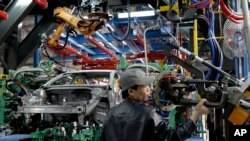Anti-China rioting in Vietnam earlier this year damaged more than 400 foreign-owned factories, sending thousands of foreign investors fleeing in fear of more violence. But foreign capital flows have resumed to pre-protest levels as the government pledges to protect investors, the economy grows and business costs remain low.
Factories pumping out clothes, furniture and consumer electronics have returned to business since the anti-China protests in May. The protests that killed 20 and injured hundreds followed China’s deployment of an oil rig in ocean waters claimed also by Vietnam. The act reignited centuries of Sino-Vietnamese hostilities, which include a 1979 border war.
But the foreign investors who power 17 percent of Vietnam’s economy and 66 percent of its exports have returned. Vietnam’s Communist government pledged to stop any further upsets. The government has also created investment conditions, including cheap factory labor, to keep foreign capital coming in. Ralf Matthaes, owner of the Ho Chi Minh-based market consultancy In Focus, says Vietnam bounced back because the government demanded stability for investors.
“I think the biggest change is that things have settled down. I don’t think there’s been an awful lot of fallout honestly. It’s business as usual. It wasn’t that big of a flare-up. The government is all powerful here and when they put their foot down they put their foot down, that’s it,” said Matthaes.
Foreign investors led by Japan, Singapore, South Korea and Taiwan have moved into Vietnam since the Communist government dropped investment barriers in 1987. Their projects have helped lift Vietnam’s $155 billion economy and eased rampant poverty by adding jobs.
Beijing’s deployment on May 2 of a rig operated by state-owned China National Offshore Oil Corp. inflamed Vietnam, which had designs for exploration in the same tract of the South China Sea near the country's east coast. As about 20,000 people protested, their rage expanded to include other foreign investors, especially those of Chinese heritage or with Chinese words in their signage. About 9,000 investors, largely Taiwanese, fled. Vietnamese authorities arrested 85 people in connection with the riots.
Since then, China and Vietnam have met formally to review the incident, and in July Beijing removed the oil rig. Ethnic Chinese now say they feel safe. Theng Bee Han, president of the Malaysian Business Chamber in Ho Chi Minh City, says ethnic Chinese are looking toward factory expansion in Vietnam.
“Putting aside the problems or the issues between Vietnam and China, from the entrepreneur’s perspective I think there is no threat at all for the Chinese investments, be they Chinese from Taiwan, Chinese from Hong Kong, Chinese from Malaysia or Chinese from Singapore. In fact people are very positive, moving toward the better side of Vietnam,” said Han.
Chinese from China are also making another run at Vietnam. China had ranked as Vietnam’s seventh largest investor before the riots. It poured $2.3 billion into the country last year, more than six times what was invested in 2012. But much of its investment is in the form of raw materials for textiles, machinery and consumer goods. Those supplies have dipped since May as Vietnam, wary of depending too much on China, explored its own resources instead.
Foreign investors are also excited by the return of Vietnam’s stock market to pre-protest levels after a 15 percent drop and by economic growth expected at 5.6 percent this year as export markets such as the United States improve economically. Analysts consider another upset unlikely as Vietnam draws half its tax revenue from foreign investment.
Michel Tosto, managing director at Viet Capital Securities in Ho Chi Minh City, says investors look back at the protest violence as a minor incident.
“It’s a short term blip. The market fell 15 percent, [which is] major, but it also recovered. So it adds to risk, but it doesn’t change anything to the long-term story,” said Tosto.
Over the long term Vietnam is expected to simplify investment permitting, expand land use rights for overseas investors, and build new transportation systems linking Ho Chi Minh City to outlying industrial areas.







